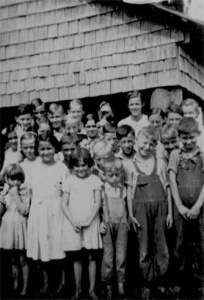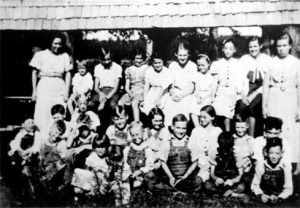
Years ago while going through my Grandma Doris’s photo drawer, I found some pictures of students of the Caton School. The children were in front of a building that did not look like the schoolhouse, so I asked Gran what building that was. She looked at the photo and said, “That’s the Canning House.”
I asked her what the Canning House was, and she stated it was a place where the women in the neighborhood could go to can their fruits and vegetables. She described the building as an open building with cedar shake shingles located behind Caton School (across from New Haven Church). It was built during the Great Depression. My Granddaddy Jones later said he remembered working on the building.

I had about forgotten about the building until this week when a colleague at work found an article while indexing obituaries. That article from the Sun Journal of July 6, 1933 follows:
FARMERS AT CATON ERECT THEIR OWN CANNING FACTORY
Plant Built by Community at Cash Outlay of $3 Serving Real Purpose
A canning plant which is expected later in the season to have an output of a thousand cans of fruit and vegetables a day, and which is now operating two days a week in preserving the products of home and relief gardens in that community is the result of a community spirit in the Caton community which is equaled in few sections of Craven County.
For some time L.G. Matthis, vocational agricultural instructor at Farm Life School, and Mrs. S.L. Homewood, home economics instructor at that school, have been especially interested in the Caton community. A Farmers’ Club was organized there in February of this year, and Mr. Matthis became leader of the women’s organization. There are about 50 members in each organization. Both are growing rapidly.
Both in the canning plant enterprise and in other agricultural and home interests, County Agent H.A. Patten and Mrs. Esther G. Willis, relief home demonstration agent, have been giving the community all the aid and encouragements possible.
Though it indirectly represents the spirit which has grown up in that community, the new canning plant may be credited directly to the two farm organizations, and to the assistance given the community by Mrs. J.D. Whitford, county welfare officer. All of the labor used in the erection of the canning plant was relief labor. Ira Whitford, leader in the community who supervised construction, put $3 into an oil drum and nails, and that was the total cash outlay.
One end was cut from the oil drum and it was placed on an iron support about a foot from the ground with the open end uppermost. About it was built a brick oven, in such a manner that flames from a fire built under the drum would surround the drum inside the oven. The top of the drum was left level with the top of the brick oven, and a heavy wooden cover was fitted to it. Stovepipe was fitted into the back of the oven to afford a draft and carry off the smoke.
Water placed in the drum can be heated in record time to the boiling point. It holds heat well, and the morning after it has been used the water is too hot to put one’s hand in and can be brought to the boiling point with ten minutes’ fire.
Tin cans of fruits and vegetables are sealed, placed on a tub bottom which fits inside the oil drum and lowered into the boiling water. Sometimes, when produce requiring longer cooking is in process, cans of produce which take but a short cooking are placed in a sack and lowered into the drum on top of the other cans. Then it can be taken out more readily when its time is up.
Over the oven with its cooking drum has been built an open shed about twenty feet square. This is what required the nails Mr. Whitford purchased. all of the material used in the construction was cut by the relief labor, including the thick shingles which cover the roof and extend down the sides about two feet beneath the eaves. Tables upon which the work is done extend around three sides of the shed.
Canning is now being done for some fifty families. Including some thirty relief gardens. The welfare department has been supplying the cans for the relief garden produce, while other families buy their own cans. The community is much interested in helping along the relief work, and it sees an increasing number of relief gardens represented in its canning and estimates that seventy-five relief gardens will be represented before the season is over.
The canning plant has been in operation for two weeks. It was estimated that 500 cans of vegetables and fruits had been the result; about 200 No. 2 cans and 300 No. 3 cans. Corn, beans, peaches, apples, huckleberries, and dewberries and squash have been canned. Later in the season it is proposed to can meats of all kinds. The plant is operated now each Tuesday and Friday, though increased amount of produce will necessitate increased operation as the season progresses.
The name of the owner is carefully written on each can before it is placed in the drum for boiling, and each person participating in the canning claims her own produce when the canning has been completed.
The Farmers’ Club and its women’s auxiliary meet every two weeks. Canning is but one of many interests, all of which are discussed at the meetings.
“Each time we visit here for a meeting,” says Mrs. Homewood, “we find the school building filled with people and everything in readiness. There are sometimes as many as 125 people, and we have found just one automobile present. The people walk as far as two and three miles to attend the meetings.”
That statement seems to summarize the community spirit and interest which is responsible for all the development there.
[End of Sun Journal article.]